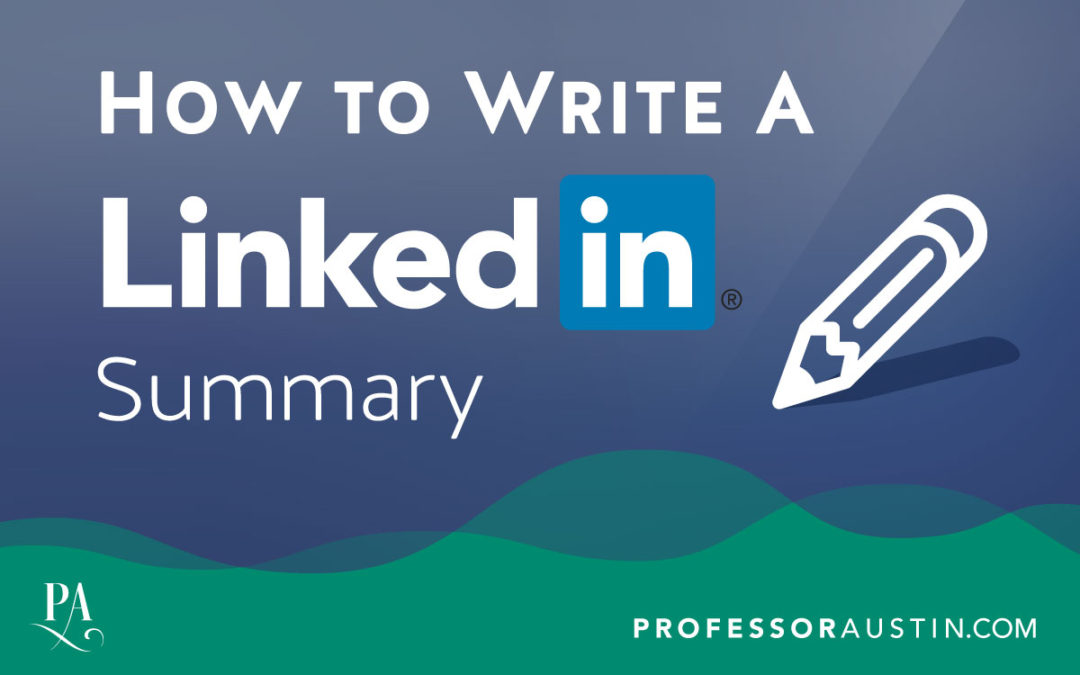If you want to learn how to write a great LinkedIn summary, you’re in the right place; today, I’m sharing my top 5 tips to help you tackle one of the most overlooked sections on LinkedIn.
If we’ve never met before, I’m Heather Austin from ProfessorAustin.com and The Career Club on Facebook, and here, I share simple solutions to help you build a business or launch a career you love.
So here’s what’s up: LinkedIn is growing at a staggering rate. It’s where most working professionals interact online. In fact, it’s been reported that 41% of millionaires use this platform. So having a well-written LinkedIn profile is crucial if you are trying to land a new job or connect with new clients.
Besides your profile photo and your headline, your summary is one of the most important sections of your profile.
I have to admit, this was one of hardest sections for me to complete in my own profile. When I first started using LinkedIn, I wasn’t sure how to showcase my skills in this section, and I certainly didn’t know how to format it.
With some trial and error, I learned how to use my LinkedIn summary to go from 100 profile views in one week to now almost 1000 profile views in one week.
Let me tell you how to do it.
Tip #1 – Write Your Summary in First Person
This is something I see so many professionals get wrong. To make your summary more conversational, write it in first person. This will make it easier and more natural for you to compose your summary, and it will show you in a more personable light.
So rather than saying something like, “Jane Doe is a driven business owner,” you would instead say, “I am a driven business owner.”
Tip #2 – Tailor Your Summary to a Specific Position or Industry
The key to tailoring your profile is to use keywords. Keywords are words or phrases found in job postings that relate to the responsibilities and qualifications of their desired candidate.
Pinpoint these keywords by examining the job posting carefully. Make a note of the words or phrases that appear multiple times.
When you compose your summary, make sure these keywords and phrases are used throughout.
Now, for step-by-step instructions on how to use LinkedIn to find a job, check out my YouTube video that addresses that directly.
Tip #3 – Include an Expertise Section
Because we’re on the topic of keywords, let’s talk about the expertise section.
This is a section that you’ll add to the very end of your summary that includes those same keywords and phrases. You can also title this section, “Specialties.” Come up with and add 15 – 20 keywords or phrases that an employer might use to search for someone with your particular set of skills.
For example, in my expertise section, I have phrases like, “LinkedIn profile strategies,” “LinkedIn profile optimization,” and “personal brand development.”
Tip #4 – Keep Your Summary Short and to the Point
LinkedIn allows you to use 2,000 characters to create your summary; however, I wouldn’t recommend using all 2,000 characters. As human beings, our attention spans keep shrinking, so make your sentences short and to the point.
Here’s a good rule of thumb: Include 2 to 3 paragraphs with 2 to 3 sentences in each paragraph. Think of this as the 2×3 Rule.
Keep in mind also that the first few lines of your summary are the most important. When someone lands on your profile, this is what they will read first. To get your audience to read more, you need to entice them with an attention-grabbing first sentence.
To better organize your content and to implement good use of whitespace, incorporate headers, subheaders, and bullet points.
Tip #5 – Show Character; Be Your True Self
One thing you can do to stand out from everyone else in your same shoes is to let your personality shine.
You can do this by showing your passion and drive for the position you’d like to have or for the industry you’re in. Use a statement describing this to start your summary.
You can also do express your personality by sharing a brief statement of your personal interests. Such as, “In my free time, I enjoy horseback riding, long walks in the park, and hot yoga.”
Tip #6 – Include a Call to Action
At the end of your summary, include some type of call to action to let your reader know how they can quickly get in touch with you.
This can be something like sharing a link to your website, online portfolio, or even your email address.
